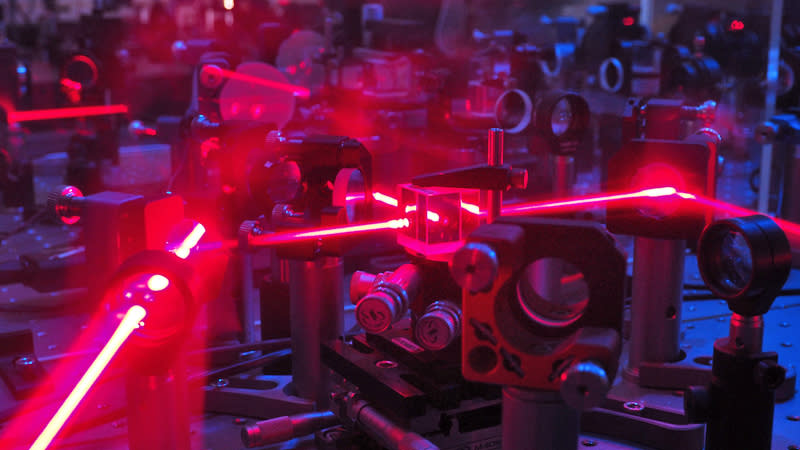QuantumMechanics
Latest

600-year-old starlight addressed a loophole in quantum theory
Quantum entanglement, where two particles are separated by space and yet inextricably linked by the laws of quantum mechanics, has already been proven to be real, but something called the "freedom-of-choice loophole" has so far made it impossible to definitively prove the theory. That is, until physicists from the University of Vienna and MIT addressed that loophole with a blast of 600-year-old starlight.

Scientists catch a classic quantum experiment on camera
If you know a bit about quantum physics, you've likely heard of the Schrödinger's Cat concept used to explain superpositions: a cat in a box with a poison flask is at once alive and dead until you look inside. Researchers have produced this oddball state in the lab before, but they're now using it to create the most detailed X-ray movies of molecules they've seen so far. A team at the SLAC National Accelerator Laboratory first blasted an iodine molecule with an optical laser, splitting the molecule into simultaneous excited and relaxed states. When the scientists hit the molecule with X-rays afterward, the light scattering off of both states created an X-ray hologram showing the excited state. After that, the SLAC group only had to capture enough of these holograms to create a movie.

AI made quantum experimentation easier for our feeble brains
Is the cat in the box alive, dead or... alive-dead? Questions like the one posed by the Schroedinger's Cat thought experiment have vexed mere mortals for far too long, and the scientific community knows that quantum mechanics is pretty tough to wrap our human brains around. So, a group of researchers at the University of Vienna developed an algorithm to help speed the quantum experimentation process along and make it altogether easier, according to APS Physics. It's dubbed Melvin and it was used in a quantum optics experiment to arrange mirrors and beam splitters to make quantum-entangled photons. Photons in Greenberger-Horne-Zeilinger states, specifically.

White House streams time travel talk for BTTF Day
The White House jumped into the Back to the Future Day hooplah by hosting a panel discussion on the feasibility of time travel. Tom Kalil, director of White House Office of Science and Technology Policy, hosted the half-hour talk, which also featured University of Queensland physicists Tim Ralph and Martin Ringbauer. The trio discuss a variety of topics including quantum mechanics and recent accelerated particle experiments, though they don't dive particularly deeply into any one subject or even get to the part about the self-lacing Nikes. Check out the full discussion below. [Image Credit: Denver Post via Getty Images]

'Spooky' experiment proves quantum entanglement is real
Einstein was wrong -- about the quantum mechanical phenomena known as superpositioning and wave form collapse, at least. A team from Australia's Griffith University and Japan's University of Tokyo, have proven that both are tangible phenomena, not simply mathematical paradoxes. See, back when he was still reigning "smartest guy on the planet," Einstein just couldn't wrap his massive intellect around the theory of superpositioning (or as he called it, "spooky action across distance"). That is, a particle in superposition effectively exists in both places at once (not unlike Schroedinger's Cat) until you observe it at either location. At which time the particle you aren't looking at ceases to exist (a process known as wave function collapse). What's more, the disappearing particle seems to know that its twin has been discovered through some mechanism that happens instantly, literally traveling faster than the speed of light -- a clear violation of Einstein's theory of relativity.

Behold the first photo of light in both wave and particle forms
You've likely read in a textbook before that light behaves both as a particle and a wave at the same time. Scientists had previously seen it behave one way or another, but it's only now that someone finally found a way to photograph light as both in a single picture since Einstein proposed its dual nature in the early 1900's. In order to photograph light, a team of scientists from the Ecole Polytechnique Federale de Lausanne (EPFL) used a novel technique and an electron microscope so powerful, there are only two in the world.

Quantum physics theory is easier to understand than you think
Wrapping your head around quantum physics is tricky, no matter how well-educated you are -- if it were easy, there wouldn't be problems making quantum computers. However, researchers at the National University of Singapore believe they've found a way to make things simpler. They've determined that wave-particle duality (where quantum objects behave like waves) is really a manifestation of the uncertainty principle, which limits your ability to know two related properties of a quantum particle. As it turns out, you can rework the math for wave-particle duality to apply to certain uncertainty relations. They're just two sides of the same coin.

Scientists simulate time travel using light particles
We may never see practical time travel in our lifetimes, if it's possible at all. However, a team at the University of Queensland has given the Doc Browns of the world a faint glimmer of hope by simulating time travel on a very, very small scale. Their study used individual photons to replicate a quantum particle traveling through a space-time loop (like the one you see above) to arrive where and when it began. Since these particles are inherently uncertain, there wasn't room for the paradoxes that normally thwart this sort of research. The particle couldn't destroy itself before it went on its journey, for example.

Fedora 19 Schrodinger's Cat released with 3D printing, Developer's Assistant, paradoxes
Fedora 19 Schrodinger's Cat may have a name that suggests it's both alive and dead, but there's no uncertainties about its release -- the finished Linux distribution is now available on Fedora's servers. The oddly-nicknamed OS mostly improves content creation. It beats Microsoft to the punch on 3D printer support by including object design and printing tools; budding programmers will also like Node.js support and a Developer's Assistant that simplifies learning new code languages. While there's many more updates than we can list here, it's safe to say that Fedora 19 is a big update for many Linux fans, whether or not they appreciate Schrodinger's quantum mechanics. You can grab the new build and its release notes at the source links.

Alt-week 8.4.12: buckyballs, bosons and bodily fluids
Alt-week peels back the covers on some of the more curious sci-tech stories from the last seven days. Remember when we told you last week that we live in a strange world? Well, we had no idea what we were talking about. Seriously, things are about to get a whole lot weirder. High school is certainly a head-scratcher, no matter how old you are, but the mathematics of social hierarchies can't hold a candle to the mysteries of the buckyball. And, if the strange behavior of the familiar carbon molecule isn't enough for you, we've got an entirely new molecule to contend with, while the once-elusive Higgs Boson is getting us closer to unlocking the secrets of the universe. It's all pretty heady stuff, which is why we're also gonna take a quick detour to the world of human waste. This is alt-week.

Flawed diamonds are perfect ingredients for quantum computing, just add time travel
Ready to suspend your brain cells in a superposition of disbelief? Good, because the latest news published in Nature is that diamonds are a quantum computer's best friend -- particularly if they're flawed. An international team of scientists sought out sub-atomic impurities in a 1mm-thick fragment of over-priced carbon and used these as qubits to perform successful calculations. A "rogue" nitrogen nucleus provided one qubit, while a free electron became a second. Unlike previous attempts at solid-state quantum computing, this new effort used an extra technique to protect the system from decoherence errors: microwave pulses were fired at the electron qubit to "time-reverse" inconsistencies in its spinning motion. Don't fully get it? Us neither. In any case, it probably won't stop jewellers tut-tutting to themselves.

University of Vienna researchers quantum leap into the cloud, ensure privacy for distributed computing
Afraid of the cloud? You're not alone, as rising concerns surrounding the security of distributed computing have led University of Vienna researchers to seek out quantum mechanics as a privacy fix. The team's findings, soon to be published in the journal Science, prove that an end user's data can remain encrypted throughout its journey to and from remote servers, essentially rendering the quantum computer's calculations as "blind." So, how exactly does this evasive entanglement work? Qubits (or quantum bits) containing the pertinent information are transmitted to a central facility where they're processed according to a specific set of measurements, leaving the resultant computations readable only by the original user. Not obtuse enough for you? Then check out the source below for a more detailed walkthrough.

Quantum entanglement could mean completely secure data transfer
By tapping into Albert Einstein's idea of "spooky action at a distance," researchers at the University of Copenhagen's Niels Bohr Institute have discovered what might be the key to completely secure data transfer -- keeping particles "entangled" for up to an hour. Until now, the link between two entangled systems could only be maintained for a fraction of a second. This development could enable a direct link between two systems of communication -- you do something to one and the other will "know." Although limited to the lab right now, scientists are working on practical applications for networking and the internets. Hey, SSH maybe it's time you started watching your back. Check out the full PR after the break. [Thanks Nan]

String theory finds an elegant use for itself with qubit entanglement and black holes
Sure, trying to wrap your head around string theory -- a study in particle physics that's trying to rectify the perceived contradictions between general relativity and quantum mechanics -- can cause more cognitive pain than a colliding god particle. That hasn't stopped anyone from trying to validate its corollaries, and in the interim, researchers like Michael Duff of the Imperial College London. Mr. Duff realized a few years ago there existed some strong relations between formulas pertaining to both black holes (relativity) and four entagled qubits (quantum mechanics). So, in his words, "In a way, there's bad news and good news in our paper. The bad news is, we're not describing the theory of everything. The good news is, we're making a very exact statement which is either right or wrong. There's no in between." We're sure some science cliques are already gearing up to get their troll on. Hit up the PDF below if you want to read it yourself.

Pressure-sensitive touchscreens show up on the not too distant horizon
Ever heard of quantum tunneling? It's the basis for the latest approach to gather steam in the never-ending quest to endue touchscreens with force recognition, and its promises are as lofty as you'd expect. Developed by UK researchers Peratech, this new methodology revolves around a 75-micrometer (less than a tenth of a millimeter) quantum tunneling composite, which display makers can add to their screens relatively cheaply and painlessly. The pressure-sensing layer consumes no power when it isn't depressed and requires a miniscule two micrometers of movement to register a touch. Japanese display maker Nissha (who counts LG and Nintendo among its customers) has grabbed a license and we're even hearing devices could be coming out as soon as April. Check the Peratech site for more info.







